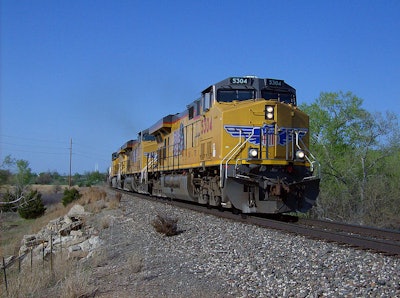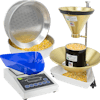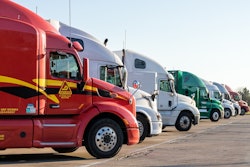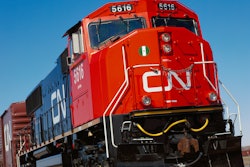
On Thursday, Union Pacific beat Wall Street estimates for quarterly profit, as the U.S. railroad operator benefited from higher volumes of grain and intermodal shipments.
Analysts expect the recovery in railroad volumes to continue in 2021, with a pick-up in demand giving way to broader-based gains in rail traffic, spurred by industrial and commodity end markets, saysReuters.
Thecompany reported2020 fourth quarter net income Thursday of $1.4 billion, or $2.05 per diluted share. These results include a previously announced $278 million pre-tax, non-cash impairment charge.
Excluding the effects of that charge, adjusted fourth quarter net income was $1.6 billion, or $2.36 per diluted share. This compares to $1.4 billion, or $2.02 per diluted share, in the fourth quarter 2019.
"These outstanding results demonstrate the true potential of our franchise as we leveraged all three profitability drivers simultaneously – volume growth, productivity, and pricing – to produce record fourth quarter results," says Lance Fritz, Union Pacific chairman, president and CEOr. "The women and men of Union Pacific persevered throughout the pandemic to provide our customers with a safe, reliable, and consistent service product."
Fourth Quarter Summary
Operating revenue of $5.1 billion was down 1% in fourth quarter 2020 compared to fourth quarter 2019. Fourth quarter business volumes, as measured by total revenue carloads, increased 3% compared to 2019. Premium volumes increased compared to 2019, while bulk was flat and industrial declined. In addition:
- Quarterly freight revenue declined 1% compared to fourth quarter 2019, as volume growth and core pricing gains were more than offset by decreased fuel surcharge revenue and a less favorable business mix.
- Union Pacific’s 61.0% reported operating ratio when adjusted for the impairment charge is an all-time quarterly record of 55.6%, 410 basis points lower than fourth quarter 2019. Lower fuel prices positively impacted the operating ratio by 90 basis points.
- Quarterly freight car velocity was 223 daily miles per car, a 1% improvement compared to fourth quarter 2019.
- Quarterly locomotive productivity was 142 gross ton-miles per horsepower day, a 13% improvement compared to fourth quarter 2019.
- Quarterly workforce productivity was 1,032 car miles per employee, an 18% improvement compared to fourth quarter 2019.
- Average maximum train length was 9,154 feet, a 12% increase compared to fourth quarter 2019.
- The company repurchased 3.8 million shares in fourth quarter 2020 at an aggregate cost of $749 million.
Summary of Fourth Quarter Freight Revenues
- Bulk up 1%
- Industrial down 7%
- Premium up 5%
2020 Full Year Summary
For the full year 2020, Union Pacific reported net income of $5.3 billion or $7.88 per diluted share. Excluding the effects of the $278 million pre-tax, non-cash impairment charge, adjusted full year net income was $5.6 billion, or $8.19 per diluted share. This compares to $5.9 billion, or $8.38 per diluted share, in 2019.
Operating revenue totaled $19.5 billion compared to $21.7 billion in 2019. Operating income totaled $7.8 billion, which decreased compared to 2019. In addition:
- Freight revenue totaled $18.3 billion, a 10% decrease compared to 2019. Carloadings were down 7% versus 2019, as all three business teams – bulk, industrial, and premium – declined due to the economic conditions brought on by the COVID-19 pandemic.
- Union Pacific’s full year 59.9% reported operating ratio when adjusted for the impairment charge is a best ever 58.5%, 210 basis points lower than 2019. Lower fuel prices positively impacted the operating ratio by 130 basis points.
- Union Pacific’s reportable personal injury rate of 0.90 incidents per 200,000 employee hours was flat compared to full year 2019. The Company’s FRA reportable rail equipment incident rate of 3.54 per million train miles improved 17% compared to full year 2019.
- Through continued implementation of precision scheduled railroading principles, Union Pacific made year-over-year improvements in its key operating performance indicators:
- Freight car velocity – 6% improvement
- Average terminal dwell – 8% improvement
- Locomotive productivity – 14% improvement
- Workforce productivity – 11% improvement
- Train length – 14% improvement
- Intermodal car trip plan compliance – 6 pt. improvement
- Manifest/Autos car trip plan compliance – 6 pt. improvement
- Fuel consumption rate, measured in gallons of fuel per thousand gross ton miles, improved 2% in 2020 compared to 2019.
- Union Pacific’s capital program in 2020 totaled $2.8 billion.
- 202年联合太平洋回购2200万股0 at an aggregate cost of $3.7 billion.
2021 Outlook
"While the economic outlook for 2021 remains uncertain, we will build off our solid 2020 performance to produce continued strong productivity through operational excellence. We expect our enhanced service product will support both solid core pricing gains while also increasing our share of the freight transportation market," Fritz said. "Our confidence in our ability to drive value for all of our stakeholders has never been greater."





















